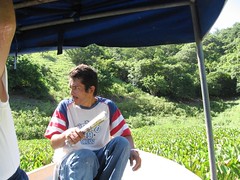 Our destination was the site of the 1983 Copapayo Massacre - the original place. And our story tellers were a survivor of the massacre and a leader of the community who was spared by not being in the wrong place at the wrong time - hence the context. The man in the picture is Rogelio. He was 10 years old in 1983. Behind his left shoulder is a white cross on the hill marking the site of the massacre.
Our destination was the site of the 1983 Copapayo Massacre - the original place. And our story tellers were a survivor of the massacre and a leader of the community who was spared by not being in the wrong place at the wrong time - hence the context. The man in the picture is Rogelio. He was 10 years old in 1983. Behind his left shoulder is a white cross on the hill marking the site of the massacre.The people of Copapayo had been struggling to survive and organizing for better conditions for years. In the state of war that was El Salvador during those years, their organizing was met with violence on the part of the military. Many of the men had left the community to fight with the guerillas, leaving mostly women, children and the elderly in the town. On November 3, 1983 a group of these remaining villagers cautiously returned home, having previously evacuated the town to avoid confrontation with the military. They had sent scouts to see if the army had left and they thought they had. Unfortunately they were mistaken and when the army saw them they came down the hill and opened fire.
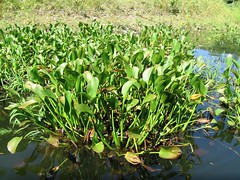 Some survived by hiding under the lily pads that were growing in the lake. Others that survived the original attack were taken on a forced death march. Rogelio survived both the shooting at the lake and the forced death march, although he saw his mother and sister killed. 142 civilians died in the Copapayo Massacre, killed by the US trained Atlacatl Battalion. As Rogelio told us the story, he looked at his hands and the ground beneath his feet. I couldn't help but be reminded that I was 11 years old in 1983, which made me a year older than Rogelio. What would it have been like to witness such savagery at that age?
Some survived by hiding under the lily pads that were growing in the lake. Others that survived the original attack were taken on a forced death march. Rogelio survived both the shooting at the lake and the forced death march, although he saw his mother and sister killed. 142 civilians died in the Copapayo Massacre, killed by the US trained Atlacatl Battalion. As Rogelio told us the story, he looked at his hands and the ground beneath his feet. I couldn't help but be reminded that I was 11 years old in 1983, which made me a year older than Rogelio. What would it have been like to witness such savagery at that age?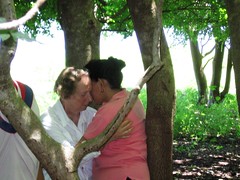 We were also joined by Mercedes on our trip to the lake. She and her husband are from Copapayo, but they had fled farther in the original evacuation and did not return in those first boats and thus were spared. Her son now works at the Centro for Arte para La Paz where we stayed in Suchitoto. She shared much of the background and context for those dark days saying something to the effect that the story needs to be told so such things never happen again. By the end of her sharing, she was quite emotional. Audrey, one of our Associates from England, was so moved she held Mercedes in a long embrace. Someone commented later that this was the very picture of the Visitation of Mary & Elizabeth.
We were also joined by Mercedes on our trip to the lake. She and her husband are from Copapayo, but they had fled farther in the original evacuation and did not return in those first boats and thus were spared. Her son now works at the Centro for Arte para La Paz where we stayed in Suchitoto. She shared much of the background and context for those dark days saying something to the effect that the story needs to be told so such things never happen again. By the end of her sharing, she was quite emotional. Audrey, one of our Associates from England, was so moved she held Mercedes in a long embrace. Someone commented later that this was the very picture of the Visitation of Mary & Elizabeth. Later we went to El Sitio Cencinero, a repopulation village across the lake where many from Copapayo resettled after spending 3 plus years in Honduras as refugees. There we saw homes, a beautiful church, and a school. We also saw children playing and reading at the library. My prayer then and now was something like, "Please God they do not ever see such savagery and inhumanity in their lives."
Later we went to El Sitio Cencinero, a repopulation village across the lake where many from Copapayo resettled after spending 3 plus years in Honduras as refugees. There we saw homes, a beautiful church, and a school. We also saw children playing and reading at the library. My prayer then and now was something like, "Please God they do not ever see such savagery and inhumanity in their lives."In El Sitio we also saw a mural that tells the story of the Copapayo Massacre. I'm including the panels of the mural below:
 The beautiful village before, then the massacre, then the names of the dead on 2 panels, and then .... hope. A peace dove, a rising sun, crops behind planted. How beautiful that their response, their hope, their prayer is life. Return, rebuild, replant. There's a lesson there.
The beautiful village before, then the massacre, then the names of the dead on 2 panels, and then .... hope. A peace dove, a rising sun, crops behind planted. How beautiful that their response, their hope, their prayer is life. Return, rebuild, replant. There's a lesson there.
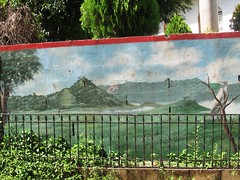
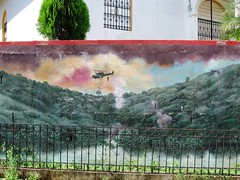


2 comments:
You're making it all come very alive for those who weren't part of the group.
Eagerly awaiting the next installation ...
Thank you for sharing your experience...I could feel in your writing the emotion that you felt hearing these stories.
Post a Comment